Multi-Criteria Analysis of a Potential Expansion of Protected Agriculture in Imbabura, Ecuador
Abstract
1. Introduction
2. Materials and Methods
2.1. Study Area Description
2.2. Selected Variables and Their Characteristics
2.3. Modeling Approaches for Greenhouse Expansion
2.3.1. GIS-AHP Integration
Variable Weighting Method
2.3.2. Maximum Entropy Model (MaxEnt)
MaxEnt Model Application and Validation
3. Results
3.1. GIS-AHP Modeling for the Potential Expansion of Agricultural Greenhouses in Imbabura
3.2. Maxent Modeling for a Possible Expansion of Agricultural Greenhouses in Imbabura
3.3. Suitability of Existing Greenhouse Locations
4. Discussion
5. Conclusions
Author Contributions
Funding
Data Availability Statement
Conflicts of Interest
References
- Barati, A.A.; Azadi, H.; Movahhed Moghaddam, S.; Scheffran, J.; Dehghani Pour, M. Agricultural expansion and its impacts on climate change: Evidence from Iran. Environ. Dev. Sustain. 2024, 26, 5089–5115. [Google Scholar] [CrossRef]
- Qayyum, M.; Zhang, Y.; Wang, M.; Yu, Y.; Li, S.; Ahmad, W.; Maodaa, S.N.; Sayed, S.R.M.; Gan, J. Advancements in technology and innovation for sustainable agriculture: Understanding and mitigating greenhouse gas emissions from agricultural soils. J. Environ. Manag. 2023, 347, 119147. [Google Scholar] [CrossRef]
- Intergubernmental Panel on Climate Change. Special Report on Climate Change and Land (Chapter 5.1.1). En Climate Change 2022: Impacts, Adaptation, and Vulnerability; Cambridge University Press: Cambridge, UK, 2022. [Google Scholar]
- Kollar, A.J. Bridging the gap between agriculture and climate: Mitigation of nitrous oxide emissions from fertilizers. Environ. Prog. Sustain. Energy 2023, 42, e14069. [Google Scholar] [CrossRef]
- Gardner, A.S.; Trew, B.T.; Maclean, I.M.D.; Sharma, M.D.; Gaston, K.J. Wilderness areas under threat from global redistribution of agriculture. Curr. Biol. 2023, 33, 4721–4726.e2. [Google Scholar] [CrossRef] [PubMed]
- Sinore, T.; Wang, F. Impact of climate change on agriculture and adaptation strategies in Ethiopia: A meta-analysis. Heliyon 2024, 10, e26103. [Google Scholar] [CrossRef]
- The World Bank. Population, Total—Ecuador. World Development Indicators. 2023. Available online: https://data.worldbank.org/indicator/SP.POP.TOTL?locations=EC (accessed on 17 April 2025).
- Cabrera, M.; Capparelli, M.V.; Ñacato-Ch, C.; Moulatlet, G.M.; López-Heras, I.; Díaz González, M.; Alvear-S, D.; Rico, A. Effects of intensive agriculture and urbanization on water quality and pesticide risks in freshwater ecosystems of the Ecuadorian Amazon. Chemosphere 2023, 337, 139286. [Google Scholar] [CrossRef] [PubMed]
- Viteri-Salazar, O.; Toledo, L. The expansion of the agricultural frontier in the northern Amazon region of Ecuador, 2000–2011: Process, causes, and impact. Land Use Policy 2020, 99, 104986. [Google Scholar] [CrossRef]
- The World Bank Ecuador—Country Climate Development Report (English); World Bank Group: Washington, DC, USA, 2024; Available online: http://documents.worldbank.org/curated/en/099090524100027132/P1793421ddff2d0281a40519e897f9b555e (accessed on 25 March 2025).
- Naciones Unidas. Objetivos y Metas de Desarrollo Sostenible—Desarrollo Sostenible. Disponible en Línea. 2015. Available online: https://www.un.org/sustainabledevelopment/es/objetivos-de-desarrollo-sostenible/ (accessed on 21 March 2025).
- Farooq, M.S.; Riaz, S.; Helou, M.A.; Khan, F.S.; Abid, A.; Alvi, A. Internet of Things in Greenhouse Agriculture: A Survey on Enabling Technologies, Applications, and Protocols. IEEE Access 2022, 10, 53374–53397. [Google Scholar] [CrossRef]
- Zhao, J.; Liu, D. Smart greenhouse agriculture: A review towards near zero energy. Discov. Cities 2025, 2, 55. [Google Scholar] [CrossRef]
- la Cecilia, D.; Tom, M.; Stamm, C.; Odermatt, D. Pixel-based mapping of open field and protected agriculture using constrained Sentinel-2 data. ISPRS Open J. Photogramm. Remote Sens. 2023, 8, 100033. [Google Scholar] [CrossRef]
- Ou, C.; Yang, J.; Du, Z.; Zhang, T.; Niu, B.; Feng, Q.; Liu, Y.; Zhu, D. Landsat-derived annual maps of agricultural greenhouse in Shandong province, China from 1989 to 2018. Remote Sens. 2021, 13, 4830. [Google Scholar] [CrossRef]
- Sun, H.; Wang, L.; Lin, R.; Zhang, B. Mapping Plastic Greenhouses with Two-Temporal Sentinel-2 Images and 1D-CNN Deep Learning. Remote Sens. 2021, 13, 2820. [Google Scholar] [CrossRef]
- Smith, A.B.; Jones, C.D. Energy-efficient operation and modeling for greenhouses: A literature review. Renew. Sustain. Energy Rev. 2020, 117, 109480. [Google Scholar] [CrossRef]
- Li, B.; Shi, B.; Yao, Z.; Kumar Shukla, M.; Du, T. Energy partitioning and microclimate of solar greenhouse under drip and furrow irrigation systems. Agric. Water Manag. 2020, 234, 106096. [Google Scholar] [CrossRef]
- Shukla, R.M.; Nazir, N.B.; Pandey, Y.; Dadhich, S.M. Influence of Protected Cultivation Structures on Vegetable Crops. J. Agric. Ecol. Res. Int. 2024, 25, 116–122. [Google Scholar] [CrossRef]
- Ghanem, A.A.; Mostafa, A.E.A.M.; Sadek, E.S. The role of management in sustainable African protected agriculture: Case study Egypt. Int. J. Sustain. Agric. Manag. Inform. 2023, 9, 320–349. [Google Scholar] [CrossRef]
- Thakur, N.; Sharma, R.; Giridhar, B.J.; Kumar, S.; Sharma, S.; Klate, A. Socioeconomic impact assessment of protected cultivation. J. Agric. Dev. Policy 2024, 33, 138–145. [Google Scholar] [CrossRef]
- Yumna, A.; Suryantini, A.; Nugroho, R.A. Does the greenhouse adoption improve farmers’ welfare? Evidence from Indonesia. Agrar. J. Agribus. Rural Dev. Res. 2024, 10, 41–52. [Google Scholar] [CrossRef]
- Serrano-Carreón, L.; Aranda-Ocampo, S.; Balderas-Ruíz, K.A.; Juárez, A.M.; Leyva, E.; Trujillo-Roldán, M.A.; Valdez-Cruz, N.A.; Galindo, E. A case study of a profitable mid-tech greenhouse for the sustainable production of tomato, using a biofertilizer and a biofungicide. Electron. J. Biotechnol. 2022, 59, 13–24. [Google Scholar] [CrossRef]
- Vanitha, S.M.; Ravi, S.C. Economic Feasibility, Status, and Future Prospects of Protected Cultivation. In Protected Cultivation: Structural Design, Crop Management Modeling, and Automation; Apple Academic Press: Palm Bay, FL, USA, 2024. [Google Scholar] [CrossRef]
- Hirvonen, K.; Bai, Y.; Headey, D.; Masters, W.A. Affordability of the EAT–Lancet reference diet: A global analysis. Lancet Glob. Health 2020, 8, e59–e66. [Google Scholar] [CrossRef]
- Stemmler, H.; Meemken, E.M. Greenhouse farming and employment: Evidence from Ecuador. Food Policy 2023, 117, 102443. [Google Scholar] [CrossRef]
- Knapp, G. Mountain Agriculture for Global Markets: The Case of Greenhouse Floriculture in Ecuador. Ann. Am. Assoc. Geogr. 2017, 107, 511–519. [Google Scholar] [CrossRef]
- Liu, X.; Xin, L. Spatial and temporal evolution and greenhouse gas emissions of China’s agricultural plastic greenhouses. Sci. Total Environ. 2023, 863, 160810. [Google Scholar] [CrossRef] [PubMed]
- Li, J.; Wang, H.; Wang, J.; Zhang, J.; Lan, Y.; Deng, Y. Combining Multi-Source Data and Feature Optimization for Plastic-Covered Greenhouse Extraction and Mapping Using the Google Earth Engine: A Case in Central Yunnan Province, China. Remote Sens. 2023, 15, 3287. [Google Scholar] [CrossRef]
- Ou, C.; Wang, Y. Tracking Spatio-Temporal Dynamics of Greenhouse-Led Cultivated Land and its Drivers in Shandong Province, China. Front. Environ. Sci. 2022, 10, 944422. [Google Scholar] [CrossRef]
- González-Orozco, C.E.; Diaz-Giraldo, R.A.; Rodriguez-Castañeda, C. An early warning for better planning of agricultural expansion and biodiversity conservation in the Orinoco high plains of Colombia. Front. Sustain. Food Syst. 2023, 7, 1192054. [Google Scholar] [CrossRef]
- Gao, C.; Wu, Q.; Dyck, M.; Lv, J.; He, H. Greenhouse area detection in Guanzhong Plain, Shaanxi, China: Spatio-temporal change and suitability classification. Int. J. Digit. Earth 2022, 15, 226–248. [Google Scholar] [CrossRef]
- Kil, S.-H.; Park, H.-M.; Park, M.; Kim, Y.I.; Lee, E. Location Selection of Urban Rooftop Greenhouses in Seoul Based on AHP and GIS. Land 2023, 12, 2187. [Google Scholar] [CrossRef]
- Mercan, Y.; Sezgin, F. The Use Of Multi-Criteria Decision Analysis (MCDA) And Geographic Information System (GIS) In Selection of Greenhouse Site Location: The Case of Aydin Region In Türkiye. Adnan Menderes Üniversitesi Ziraat Fakültesi Derg. 2023, 20, 149–158. [Google Scholar] [CrossRef]
- LaRota-Aguilera, M.J.; Zapata-Caldas, E.; Buitrago-Bermúdez, O. New criteria for sustainable land use planning of metropolitan green infrastructures in the tropical Andes. Landsc. Ecol. 2024, 39, 112. [Google Scholar] [CrossRef]
- Kleemann, J.; Koo, H.; Hensen, I.; Mendieta-Leiva, G.; Kahnt, B.; Kurze, C.; Inclan, D.J.; Cuenca, P.; Noh, J.K.; Hoffmann, M.H.; et al. Priorities of action and research for the protection of biodiversity and ecosystem services in continental Ecuador. Biol. Conserv. 2022, 265, 109404. [Google Scholar] [CrossRef]
- Koo, H.; Kleemann, J.; Cuenca, P.; Noh, J.K.; Fürst, C. Implications of landscape changes for ecosystem services and biodiversity: A national assessment in Ecuador. Ecosyst. Serv. 2024, 69, 101652. [Google Scholar] [CrossRef]
- Correa-Pinilla, D.E.; Gutiérrez-Vanegas, A.J.; Gil-Restrepo, J.P.; Martínez-Atencia, J.; Córdoba-Gaona, O.d.J. Agroecological and South American leaf blight escape zones for rubber cultivation in Colombia. Agron. J. 2022, 114, 2830–2844. [Google Scholar] [CrossRef]
- Esri. Presence-Only Prediction (Spatial Statistics). ArcGIS Pro Tool Reference. Available online: https://pro.arcgis.com/es/pro-app/latest/tool-reference/spatial-statistics/presence-only-prediction.htm (accessed on 24 February 2025).
- França, L.C.d.J.; Jarochinski e Silva, C.S.; Mucida, D.P.; Severino da Costa, J.; Gomide, L.R. Towards renewable energy projects under sustainable watersheds principles for forest biomass supply. Biomass Bioenergy 2023, 176, 106916. [Google Scholar] [CrossRef]
- Ivale, A.H.; de Alencar Nääs, I. Precision Agriculture Impact on Food Production in Brazil. IFIP Adv. Inf. Commun. Technol. 2022, 664, 43–49. [Google Scholar] [CrossRef]
- Sethuraman, S.; Alshahrani, H.M.; Tamizhselvi, A.; Sujaatha, A. Assessment of coastal vulnerability using AHP and machine learning techniques. J. S. Am. Earth Sci. 2024, 147, 105107. [Google Scholar] [CrossRef]
- Zuluaga, A.; Etter, A.; Nepstad, D.; Chará, J.; Stickler, C.; Warren, M. Colombia’s pathway to a more sustainable cattle sector: A spatial multi-criteria analysis. Land Use Policy 2021, 109, 105596. [Google Scholar] [CrossRef]
- Vizuete-Montero, M.O.; Figueroa-Saavedra, H.F.; Barbaru-Grajales, A.D.; Zapata-Mayorga, H.A.; Herrera-Ocaña, H.R.; Moya, W. Physio-edaphoclimatic factors show optimal soil suitability for three tropical crops in the Ecuadorian Amazon. Sci. Agric. 2024, 81, e20220214. [Google Scholar] [CrossRef]
- Food Agriculture Organization of the United Nations. Integrating Spatial Planning into Sustainable Rural Development: Aframework Aligned with SDG2; FAO: Rome, Italy, 2022. [Google Scholar]
- Prefectura Imbabura. Plan de Desarrollo y Ordenamiento Territorial de la Provincia de Imbabura (2015–2035); Prefectura Imbabura: Ibarra, Ecuador, 2018. [Google Scholar]
- Gobierno Provincial de Imbabura. Información Básica del Geoparque Imbabura. Geoparque Imbabura. Available online: https://geoparque.imbabura.gob.ec/index.php/es/geoparque/informacion-basica (accessed on 27 February 2025).
- Albuja-Illescas, L.M.; Carrión-Burgos, A.M.; Jiménez-Lao, R.; Lao, M.T. Diagnosis of Protected Agriculture in Imbabura—Ecuador, Period 2016–2023. Agronomy 2025, 15, 166. [Google Scholar] [CrossRef]
- World Bank Climate Change Knowledge Portal. Ecuador. Disponible en Líne. 2021. Available online: https://climateknowledgeportal.worldbank.org/country/ecuador/climate-data-historical (accessed on 13 March 2025).
- Food Agriculture Organization of the United Nations. A Framework for Land Evaluation; Soils Bulletin 32; FAO: Rome, Italy, 1976. [Google Scholar]
- Sun, M.; He, Y.; Li, C. Spatial heterogeneity of agroecological factors and their implications for sustainable land use planning in mountainous zones. Geoderma 2024, 437, 116582. [Google Scholar] [CrossRef]
- Khatib, A.; Sizov, A.P. Mapping the spatial distribution and potential expansion of agricultural plastic greenhouses in Tartus, Syria using GIS and remote sensing techniques. Geocarto Int. 2022, 38, 1–24. [Google Scholar] [CrossRef]
- Arias-Muñoz, P.; Cabrera-García, S.; Jácome-Aguirre, G. A Multicriteria Geographic Information System Analysis of Wildfire Susceptibility in the Andean A Multicriteria Geographic Information System Analysis of Wildfire Susceptibility in the Andean Region: A Case Study in Ibarra, Ecuador. Fire 2024, 7, 81. [Google Scholar] [CrossRef]
- Sathiyamurthi, S.; Saravanan, S.; Sankriti, R.; Aluru, M.; Sivaranjani, S.; Srivel, R. Integrated GIS and AHP techniques for land suitability assessment of cotton crop in Perambalur District, South India. Int. J. Syst. Assur. Eng. Manag. 2024, 15, 267–278. [Google Scholar] [CrossRef]
- Sekhar, S.; Dutta, S.; Sahana, M.; Areendran, G.; Raj, K. Assessing Impact of Climate Variability on Potential Agricultural Land Suitability in Nalanda District, Bihar. In Sustainable Development Goals Series: Vol. Part F2706; Springer: Cham, Switzerland, 2022. [Google Scholar] [CrossRef]
- Choudhary, K.; Boori, M.S.; Shi, W.; Valiev, A.; Kupriyanov, A. Agricultural land suitability assessment for sustainable development using remote sensing techniques with analytic hierarchy process. Remote Sens. Appl. Soc. Environ. 2023, 32, 101051. [Google Scholar] [CrossRef]
- Morán-Alonso, N.; Viedma-Guiard, A.; Simón-Rojo, M.; Córdoba-Hernández, R. Agricultural Land Suitability Analysis for Land Use Planning: The Case of the Madrid Region. Land 2025, 14, 134. [Google Scholar] [CrossRef]
- Demir, S. Determination of suitable agricultural areas and current land use in Isparta Province, Türkiye, through a linear combination technique and geographic information systems. Environ. Dev. Sustain. 2024, 26, 13455–13493. [Google Scholar] [CrossRef]
- Sabljić, L.; Lukić, T.; Bajić, D.; Marković, R.; Spalević, V.; Delić, D.; Radivojević, A.R. Optimizing agricultural land use: A GIS-based assessment of suitability in the Sana River Basin, Bosnia and Herzegovina. Open Geosci. 2024, 16, 20220683. [Google Scholar] [CrossRef]
- Karna, B.K.; Shrestha, S.; Koirala, H.L. GIS based Approach for Suitability Analysis of Residential Land Use. Geogr. J. Nepal 2023, 16, 35–50. [Google Scholar] [CrossRef]
- Aldababseh, A.; Temimi, M.; Maghelal, P.; Branch, O.; Wulfmeyer, V. Multi-criteria evaluation of irrigated agriculture suitability to achieve food security in an arid environment. Sustainability 2018, 10, 803. [Google Scholar] [CrossRef]
- Ambarwulan, W.; Nahib, I.; Widiatmaka, W.; Dewi, R.S.; Munajati, S.L.; Suwarno, Y.; Sutrisno, D.; Suprajaka, S. Delineating suitable site for settlement in potential earthquake vulnerable areas using spatial multi-criteria decision analysis in the Sukabumi regency, Indonesia. J. Water Land Dev. 2022, 53, 10–21. [Google Scholar] [CrossRef]
- Bagheri, M.; Sulaiman, W.N.A.; Vaghefi, N. Application of geographic information system technique and analytical hierarchy process model for land-use suitability analysis on coastal area. J. Coast. Conserv. 2013, 17, 1–10. [Google Scholar] [CrossRef]
- Malczewski, J.; Jankowski, P. Emerging trends and research frontiers in spatial multicriteria analysis. Int. J. Geogr. Inf. Sci. 2020, 34, 1257–1282. [Google Scholar] [CrossRef]
- Saaty, R.W. The analytic hierarchy process-what it is and how it is used. Math. Model. 1987, 9, 161–176. [Google Scholar] [CrossRef]
- Saaty, T.L. How to make a decision: The analytic hierarchy process. Eur. J. Oper. Res. 1990, 48, 9–26. [Google Scholar] [CrossRef]
- Benito, B.P.d.; Peñas, J.G.d. Greenhouses, land use change, and predictive models: MaxEnt and Geomod working together. In Environmental Science and Engineering; Springer: Berlin/Heidelberg, Germany, 2008. [Google Scholar] [CrossRef]
- Fitzgibbon, A.; Pisut, D.; Fleisher, D. Evaluation of Maximum Entropy (Maxent) Machine Learning Model to Assess Relationships between Climate and Corn Suitability. Land 2022, 11, 1382. [Google Scholar] [CrossRef]
- Ahmadi, M.; Hemami, M.R.; Kaboli, M.; Shabani, F. MaxEnt brings comparable results when the input data are being completed; Model parameterization of four species distribution models. Ecol. Evol. 2023, 13, e9827. [Google Scholar] [CrossRef] [PubMed]
- Su, P.; Zhang, A.; Wang, R.; Wang, J.; Gao, Y.; Liu, F. Prediction of future natural suitable areas for rice under representative concentration pathways (Rcps). Sustainability 2021, 13, 1580. [Google Scholar] [CrossRef]
- Phillips, S.J.; Anderson, R.P.; Schapire, R.E. Maximum entropy modeling of species geographic distributions. Ecol. Model. 2006, 190, 231–259. [Google Scholar] [CrossRef]
- Yang, X.Q.; Kushwaha, S.P.S.; Saran, S.; Xu, J.; Roy, P.S. Maxent modeling for predicting the potential distribution of medicinal plant, Justicia adhatoda L. in Lesser Himalayan foothills. Ecol. Eng. 2013, 51, 83–87. [Google Scholar] [CrossRef]
- Gyamfi, E.K.; ElSayed, Z.; Kropczynski, J.; Yakubu, M.A.; Elsayed, N. Agricultural 4.0 Leveraging on Technological Solutions: Study for Smart Farming Sector. arXiv 2024, arXiv:2401.00814. [Google Scholar] [CrossRef]
- Phani, V.; Khan, M.R.; Dutta, T.K. K. Plant-parasitic nematodes as a potential threat to protected agriculture: Current status and management options. Crop Prot. 2021, 144, 105573. [Google Scholar] [CrossRef]
- Jellason, N.P.; Robinson, E.J.Z.; Chapman, A.S.A.; Neina, D.; Devenish, A.J.M.; Po, J.Y.T.; Adolph, B. A systematic review of drivers and constraints on agricultural expansion in sub-saharan africa. Land 2021, 10, 332. [Google Scholar] [CrossRef]
- Al-Maimani, A.M.; Al-Ismaili, A.M.; Al-Maktoumi, A.K.; Charabi, Y. Spatio-Temporal Distribution of Greenhouses and Affecting Driving Factors in Al-Batinah South, Oman, Using GIS Mapping. Am.-Eurasian J. Sustain. Agric. 2019, 13, 13–33. [Google Scholar] [CrossRef]
- Lin, J.; Jin, X.; Ren, J.; Liu, J.; Liang, X.; Zhou, Y. Rapid mapping of large-scale greenhouse based on integrated learning algorithm and google earth engine. Remote Sens. 2021, 13, 1245. [Google Scholar] [CrossRef]
- Zhang, Y.; Wu, L.; Yu, L.; Long, H.; Li, W. Greenhouse-mulched farmland transition: Theory and progress. Dili Yanjiu 2024, 43, 519–534. [Google Scholar] [CrossRef]
- Dhandare, K.M.; Waghole, S.B.; Kshirsagar, A. Opportunities and Challenges in Protected Cultivation in India. Int. J. Sci. Res. Eng. Manag. 2024, 8, 1–6. [Google Scholar] [CrossRef]
- Benke, K.; Tomkins, B. Future food-production systems: Vertical farming and controlled-environment agriculture. Sustain. Sci. Pract. Policy 2017, 19, 2250073. [Google Scholar] [CrossRef]
- Montero, J.I.; Stanghellini, C.; Castilla, N. Greenhouse technology for sustainable agriculture: A review of socio-economic and environmental impacts. J. Agric. Eng. Biotechnol. 2024, 12, 45–59. [Google Scholar]
- Djibrilla, A.; Saidou, A.; Mahaman, M. Environmental challenges in greenhouse agriculture: Plastic waste management and sustainable solutions. Sustainability 2022, 14, 1359. [Google Scholar] [CrossRef]
- Liu, S.; Deichmann, M.; Moro, M.A.; Andersen, L.S.; Li, F.; Dalgaard, T.; McKnight, U.S. Targeting sustainable greenhouse agriculture policies in China and Denmark: A comparative study. Land Use Policy 2022, 119, 106148. [Google Scholar] [CrossRef]
- Yu, B.; Song, W.; Lang, Y. Spatial patterns and driving forces of greenhouse land change in Shouguang City, China. Sustainability 2017, 9. [Google Scholar] [CrossRef]
- Fernández, J.R.; Torres, M.; Martínez, L. Balancing agricultural expansion and biodiversity conservation: A multi-criteria spatial planning approach. Agric. Ecosyst. Environ. 2022, 326, 107784. [Google Scholar] [CrossRef]
- Kumar, P.; Singh, R. GIS-based multi-criteria analysis for identifying suitable sites for agricultural development. Sustainability 2021, 13, 7703. [Google Scholar] [CrossRef]
- Bondarev, B.; Nosov, S.; Antipov, O.; Papikian, L. Urban land use planning within the system of sustainable urban development management. E3S Web Conf. 2019, 110, 8. [Google Scholar] [CrossRef]
- Galli, N.; Chiarelli, D.D.; Ricciardi, L.; Rulli, M.C. A Blue Water Scarcity-Based Method for Hydrologically Sustainable Agricultural Expansion Design. Water Resour. Res. 2023, 59, e2023WR034473. [Google Scholar] [CrossRef]
- Forkuor, G.; Amponsah, W.; Oteng-Darko, P.; Osei, G. Safeguarding food security through large-scale adoption of agricultural production technologies: The case of greenhouse farming in Ghana. Clean. Eng. Technol. 2022, 6, 100384. [Google Scholar] [CrossRef]
- Zhong, T.; Si, Z.; Shi, L.; Ma, L.; Liu, S. Impact of state-led food localization on suburban districts’ farmland use transformation: Greenhouse farming expansion in Nanjing city region, China. Landsc. Urban Plan. 2020, 202, 103872. [Google Scholar] [CrossRef]
- Liu, M.; Qi, D.; Zhong, T. Agricultural development policy diffusion associated with leading cadre’s experience and expansion of protected agriculture in China. Front. Environ. Sci. 2023, 11, 1078565. [Google Scholar] [CrossRef]
- Ateka, J.M.; Mbeche, R.M.; Muendo, K.M. Determinants of protected tomato production technologies among smallholder peri-urban producers in kiambu county, kenya. J. Agric. Rural Dev. Trop. Subtrop. 2021, 122, 43–52. [Google Scholar] [CrossRef]
- Ravani, M.; Ghasemi, S.; Mirzapour, M. Strategies to enhance smallholder farmer access to greenhouse technologies: Policy and innovation perspectives. Agriculture 2023, 13, 1012. [Google Scholar] [CrossRef]
- Joensuu, M.; Aakkula, J.; Huuskonen, S. Inclusive financing and innovation systems for smallholder greenhouse farmers in developing countries. World Dev. Perspect. 2021, 23, 100311. [Google Scholar] [CrossRef]
- Ajayi, O.O.; Toromade, A.S.; Olagoke, A. Climate-Smart Agricultural Finance (CSAF): A model for sustainable investments in agriculture. WJARR 2024, 24, 1–11. [Google Scholar] [CrossRef]
- Maraveas, C.; Karavas, C.S.; Loukatos, D.; Bartzanas, T.; Arvanitis, K.G.; Symeonaki, E. Agricultural Green-houses: Resource Management Technologies and Perspectives for Zero Greenhouse Gas Emissions. Agriculture 2023, 13, 1464. [Google Scholar] [CrossRef]
- Forster, E.J.; Styles, D.; Healey, J.R. Temperate forests can deliver future wood demand and climate-change mitigation dependent on afforestation and circularity. Nat. Commun. 2025, 16, 3872. [Google Scholar] [CrossRef] [PubMed]
- Niu, J.; Jin, G.; Zhang, L. Territorial spatial zoning based on suitability evaluation and its impact on ecosystem services in Ezhou city. J. Geogr. Sci. 2023, 33, 2278–2294. [Google Scholar] [CrossRef]
- Wieckowski, J.; Sałabun, W.; Kizielewicz, B.; Baczkiewicz, A.; Shekhovtsov, A.; Paradowski, B.; Watróbski, J. Recent advances in multi-criteria decision analysis: A comprehensive review of applications and trends. Int. J. Knowl.-Based Intell. Eng. Syst. 2023, 27. [Google Scholar] [CrossRef]


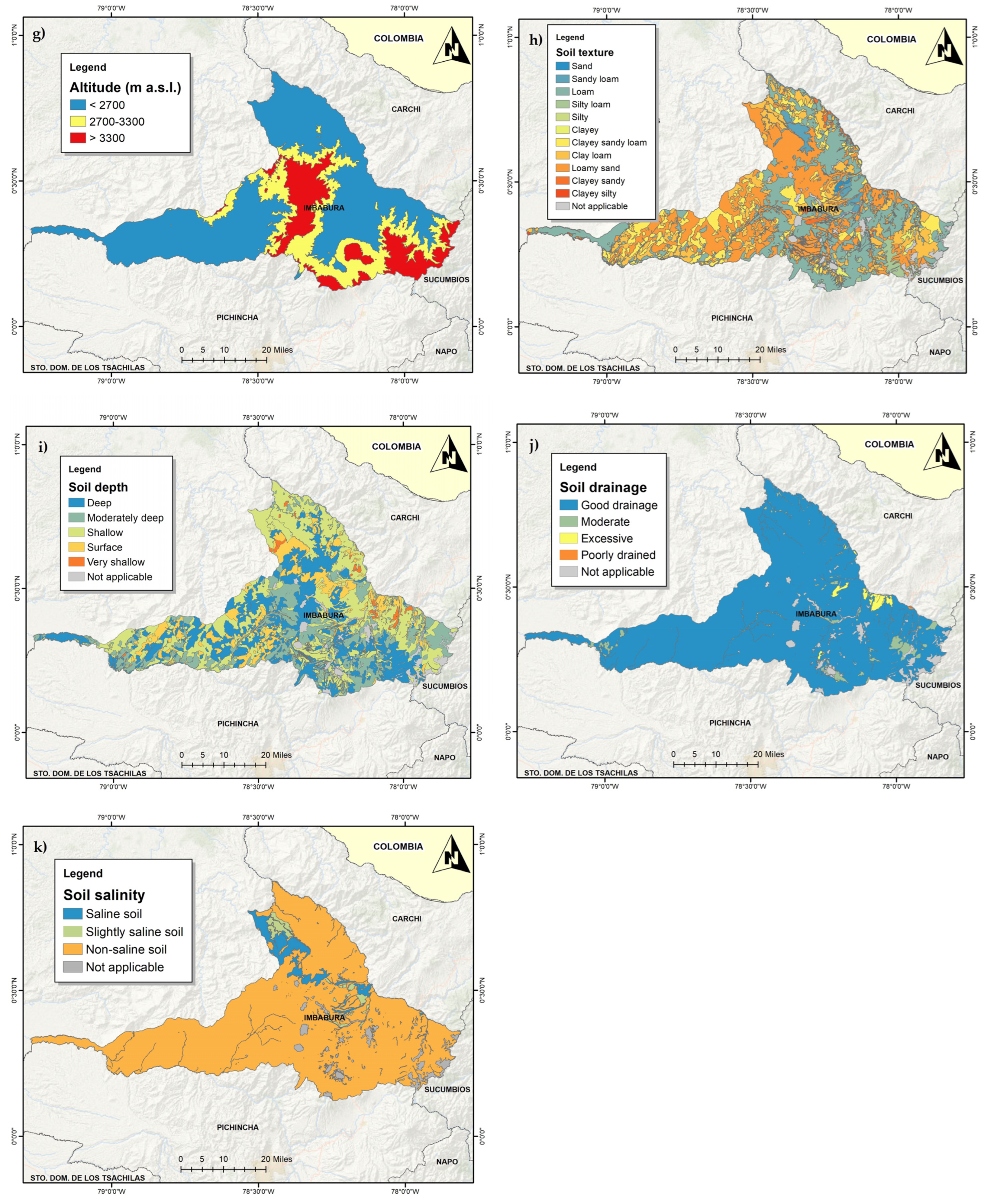
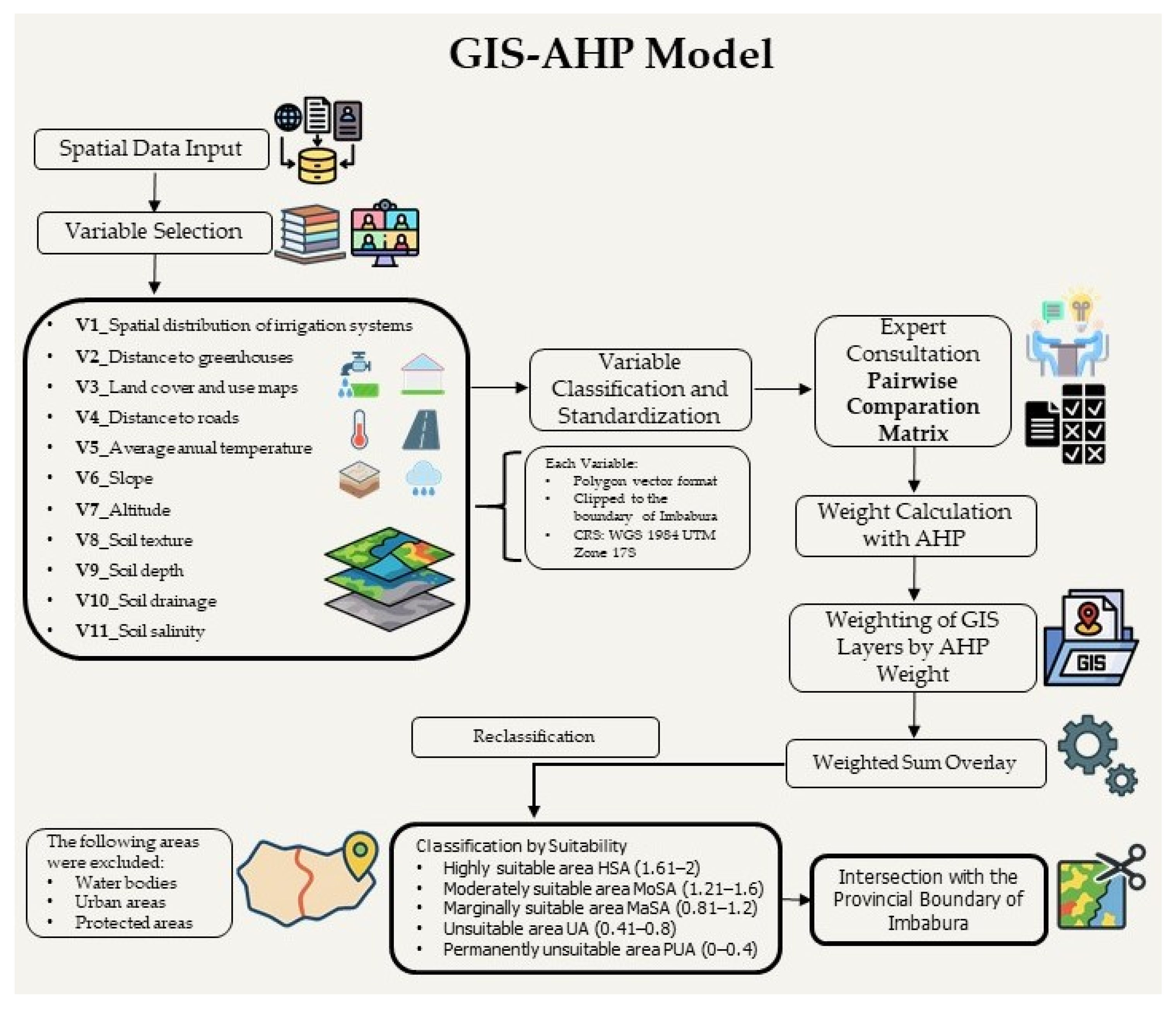

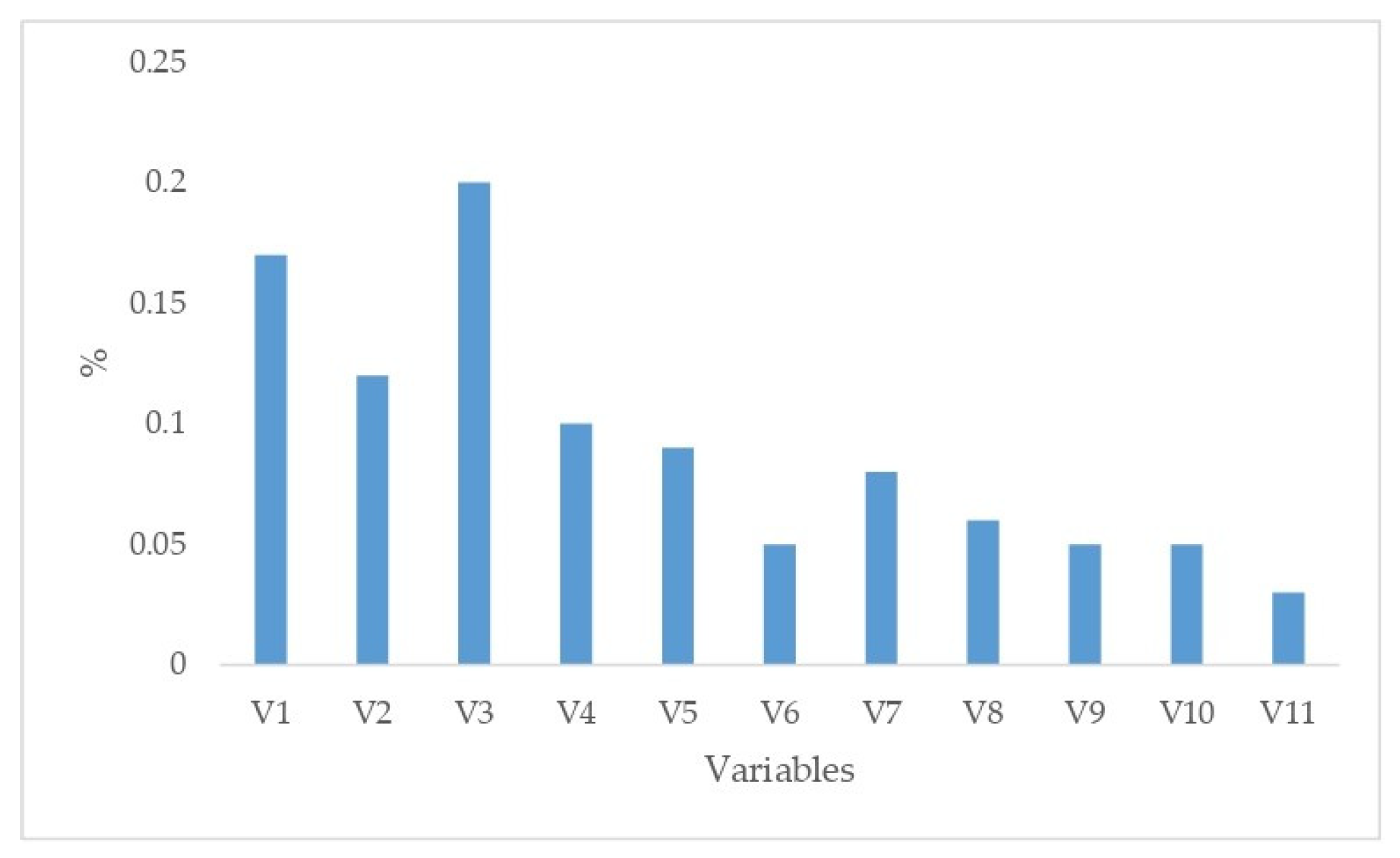
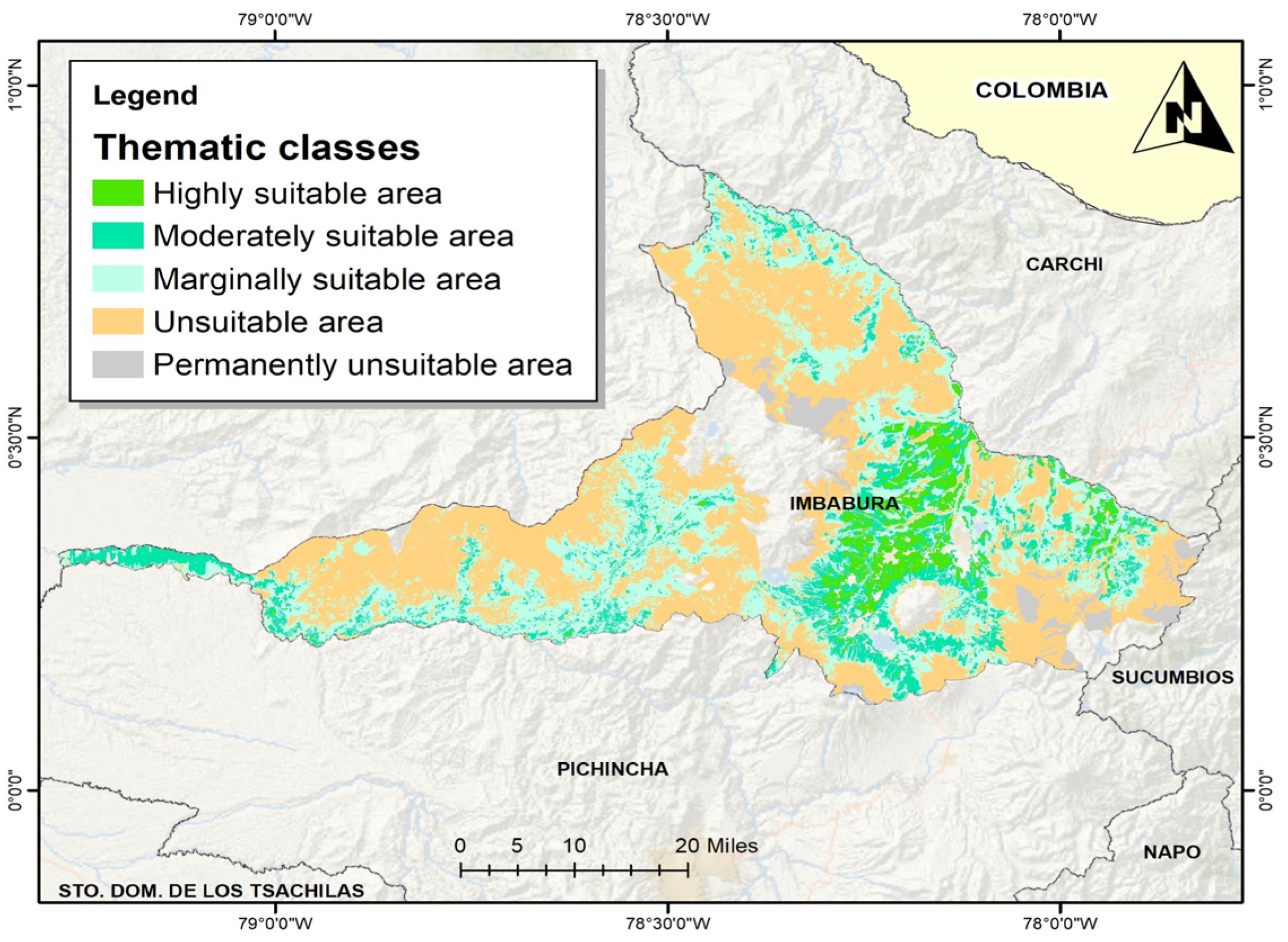
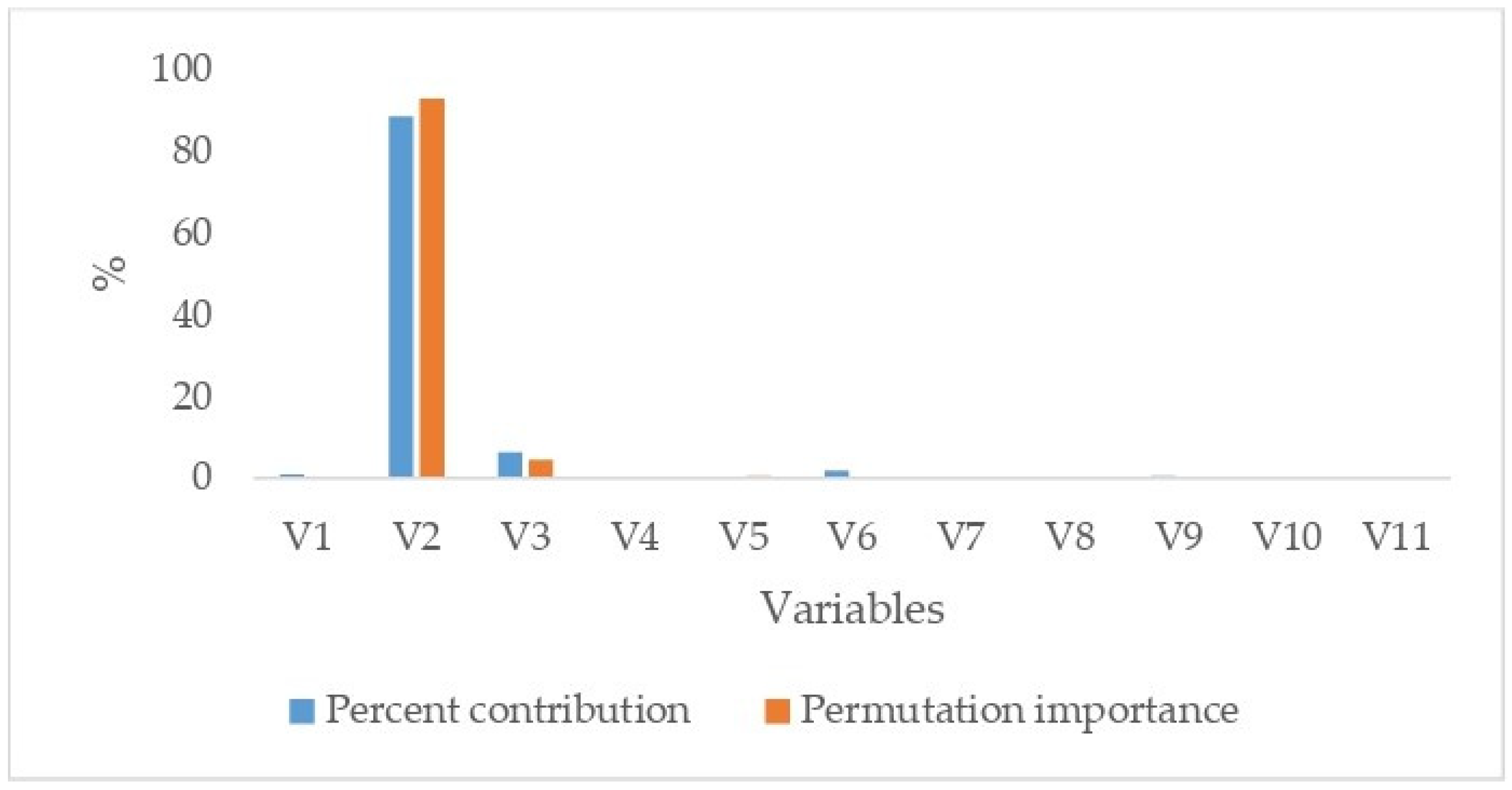
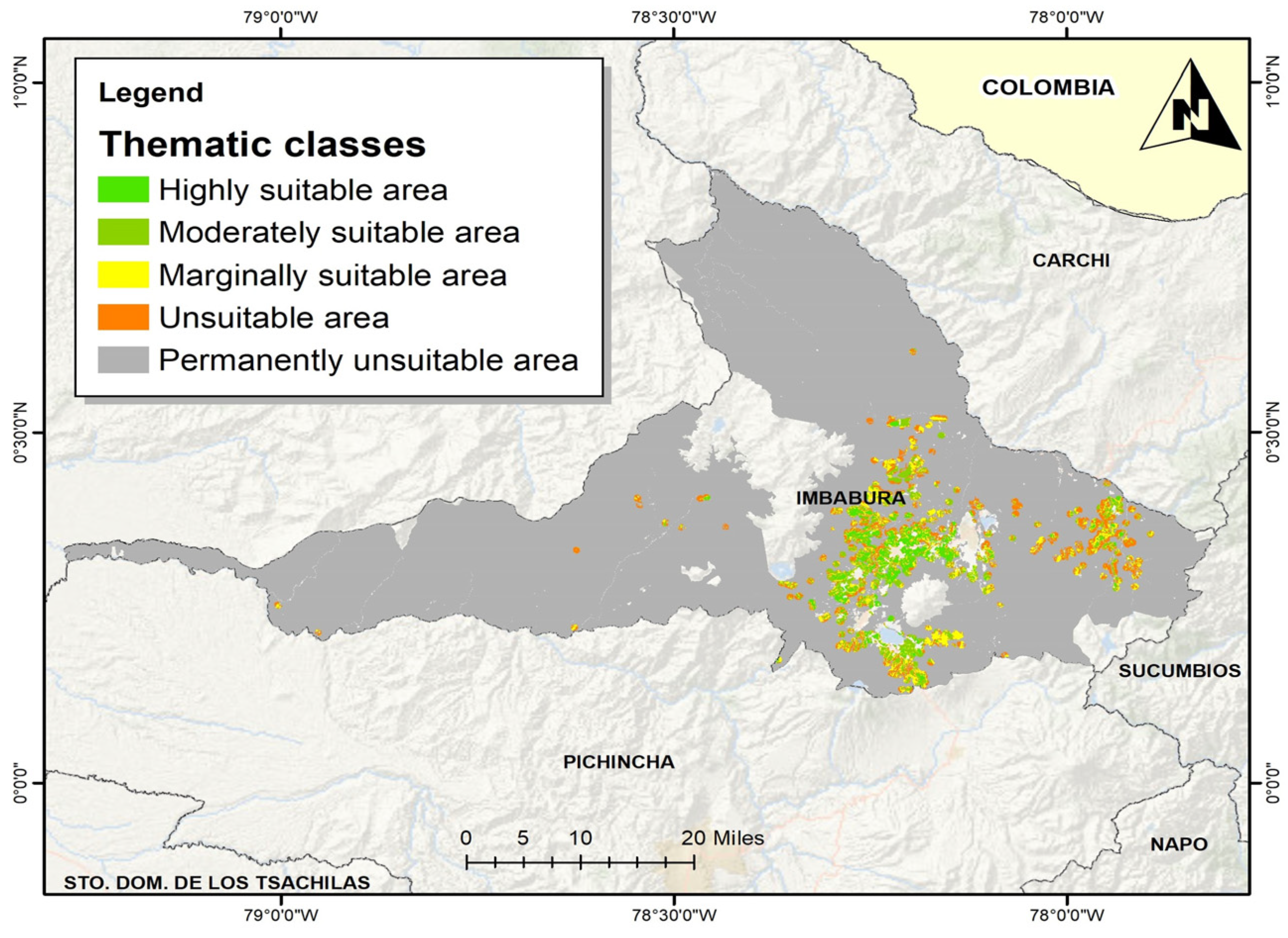
| Data Category | Variable Name | Range/Units | Assigned Value | Variable Code |
|---|---|---|---|---|
| Water resources | Spatial distribution of irrigation systems | Yes | 2 | V1 |
| No | 0 | |||
| Agricultural clustering | Distance to greenhouses | 0–500 m | 2 | V2 |
| 500–1000 m | 1 | |||
| >1000 m | 0 | |||
| Ecological Criterion | Land cover and use maps | Agricultural | 2 | V3 |
| Livestock | 1 | |||
| Other uses | 0 | |||
| Infraestructure Criterion | Distance to roads | 0–500 m | 2 | V4 |
| 500–1000 m | 1 | |||
| >1000 m | 0 | |||
| Climatic criteron | Average anual temperature | 12–24 °C | 2 | V5 |
| 8–12 °C | 1 | |||
| <8 and >24 | 0 | |||
| Topographic criterion | Slope | 0–25% | 2 | V6 |
| 25–45% | 1 | |||
| >45% | 0 | |||
| Altitude | 0–2700 a.m.s.l. | 2 | V7 | |
| 2700–3000 a.m.s.l. | 1 | |||
| >3000 a.m.s.l | 0 | |||
| Soil resources | Soil texture | Sandy Loam, Loam, Clay-Loam Sandy, Clay Loam, Sandy Loam, Silty Loam | 2 | V8 |
| Clay-Sandy, Clay-Silty, Silty | 1 | |||
| 100% Sandy, Clayey | 0 | |||
| Soil depth | Moderately | 2 | V9 | |
| Shallow | 1 | |||
| Superficial | 0 | |||
| Soil drainage | Good | 2 | V10 | |
| Moderate | 1 | |||
| Excessive | 0 | |||
| Soil salinity | Non-saline | 2 | V11 | |
| Slightly saline | 1 | |||
| Saline | 0 |
| Scale | Definition | Scale | Definition |
|---|---|---|---|
| 1 | i and j have equal importance | ||
| 3 | i is slightly more preferable than j | 1/3 | i is slightly less preferable than j |
| 5 | i is more preferable than j | 1/5 | i is less preferable than j |
| 7 | i is strongly more preferable than j | 1/7 | i is strongly less preferable than j |
| 9 | i is extremely more preferable than j | 1/9 | i is extremely less preferable than j |
| V1 | V2 | V3 | V4 | V5 | V6 | V7 | V8 | V9 | V10 | V11 | Ci | λi | |
|---|---|---|---|---|---|---|---|---|---|---|---|---|---|
| V1 | 1 | 2 | 1/5 | 3 | 2 | 4 | 3 | 4 | 4 | 4 | 5 | 0.17 | 1.503 |
| V2 | 1/2 | 1 | 1/3 | 2 | 2 | 2 | 2 | 3 | 3 | 3 | 3 | 0.12 | 1.098 |
| V3 | 5 | 3 | 1 | 3 | 2 | 2 | 2 | 3 | 3 | 3 | 3 | 0.20 | 0.958 |
| V4 | 1/3 | 1/2 | 1/3 | 1 | 2 | 2 | 2 | 3 | 3 | 3 | 3 | 0.10 | 1.223 |
| V5 | 1/2 | 1/2 | 1/2 | 1/2 | 1 | 2 | 2 | 2 | 3 | 3 | 3 | 0.09 | 1.057 |
| V6 | 1/4 | 1/2 | 1/2 | 1/2 | 1/2 | 1 | 1/3 | 1/3 | 3 | 1/3 | 3 | 0.05 | 1.204 |
| V7 | 1/3 | 1/2 | 1/2 | 1/2 | 1/2 | 3 | 1 | 2 | 2 | 2 | 3 | 0.08 | 1.083 |
| V8 | 1/4 | 1/3 | 1/3 | 1/3 | 1/2 | 3 | 1/2 | 1 | 2 | 2 | 3 | 0.06 | 1.212 |
| V9 | 1/4 | 1/3 | 1/3 | 1/3 | 1/3 | 1/3 | 1/2 | 1/2 | 1 | 3 | 3 | 0.05 | 1.167 |
| V10 | 1/4 | 1/3 | 1/3 | 1/3 | 1/3 | 3 | 1/2 | 1/2 | 1/3 | 1 | 3 | 0.05 | 1.189 |
| V11 | 1/5 | 1/3 | 1/3 | 1/3 | 1/3 | 1/3 | 1/3 | 1/3 | 1/3 | 1/3 | 1 | 0.03 | 0.897 |
| ∑ | 8.87 | 9.33 | 4.70 | 11.83 | 11.50 | 22.67 | 14.17 | 19.67 | 24.67 | 25 | 33 | 1.00 | 12.59 |
| Area of Thematic Classes | Range | |
|---|---|---|
| Minimum | Maximum | |
| Highly suitable area (HSA) | 1.61 | 2.0 |
| Moderately suitable area (MoSA) | 1.21 | 1.6 |
| Marginally suitable area (MaSA) | 0.81 | 1.2 |
| Unsuitable area (UA) | 0.41 | 0.8 |
| Permanently unsuitable area (PUA) | 0 | 0.4 |
| Variable | Percent Contribution |
|---|---|
| V1 | 0.17 |
| V2 | 0.12 |
| V3 | 0.20 |
| V4 | 0.10 |
| V5 | 0.09 |
| V6 | 0.05 |
| V7 | 0.08 |
| V8 | 0.06 |
| V9 | 0.05 |
| V10 | 0.05 |
| V11 | 0.03 |
| Thematic Classes | Surface Area per Canton (ha) | |||||||
|---|---|---|---|---|---|---|---|---|
| Antonio Ante | Cotacachi | Ibarra | Otavalo | Pimampiro | Urcuquí | Total | % | |
| HSA | 3707.51 | 3485.74 | 5497.51 | 1188.66 | 1699.61 | 5182.61 | 20,761.64 | 4.4 |
| MoSA | 1691.94 | 16,444.48 | 12,337.95 | 9642.02 | 3308.96 | 5422.76 | 48,848.11 | 10.3 |
| MaSA | 1392.15 | 54,087.71 | 37,564.97 | 16,254.55 | 9259.25 | 15,833.06 | 134,391.69 | 28.5 |
| US | 144.33 | 75,708.34 | 48,266.54 | 17,255.49 | 16,480.37 | 38,206.01 | 196,061.08 | 41.6 |
| PUA | 1270.11 | 31,730.3 | 6864.49 | 5432.96 | 13,573.87 | 12,076.66 | 70,948.39 | 15.0 |
| TOTAL | 8206.04 | 181,456.57 | 110,531.46 | 49,773.68 | 44,322.06 | 76,721.1 | 471,010.91 | 100.0 |
| Variable | Percent Contribution | Permutation Importance |
|---|---|---|
| V1 | 1 | 0.5 |
| V2 | 88.7 | 93 |
| V3 | 6.4 | 4.6 |
| V4 | 0.2 | 0.1 |
| V5 | 0.5 | 0.6 |
| V6 | 1.9 | 0.2 |
| V7 | 0 | 0 |
| V8 | 0.2 | 0 |
| V9 | 0.6 | 0.3 |
| V10 | 0.5 | 0.2 |
| V11 | 0.1 | 0.4 |
| Thematic Classes | Surface Area per Canton (ha) | |||||||
|---|---|---|---|---|---|---|---|---|
| Antonio Ante | Cotacachi | Ibarra | Otavalo | Pimampiro | Urcuquí | Total | % | |
| HSA | 1898.46 | 1394.89 | 844.13 | 997.38 | 290.53 | 192.76 | 5618.15 | 1.2 |
| MoSA | 950.06 | 1782.79 | 1150.80 | 2296.57 | 974.91 | 1500.28 | 8655.41 | 1.8 |
| MaSA | 864.35 | 1329.74 | 1193.25 | 2287.75 | 1328.93 | 1572.34 | 8576.35 | 1.8 |
| US | 814.10 | 2132.76 | 1971.52 | 1916.00 | 2823.67 | 1592.79 | 11,250.84 | 2.4 |
| PUA | 11,855.77 | 152,958.75 | 109,552.49 | 46,691.51 | 40,531.87 | 75,319.77 | 436,910.16 | 92.8 |
| TOTAL | 16,382.74 | 159,598.93 | 114,712.19 | 54,189.20 | 45,949.90 | 80,177.95 | 471,010.91 | 100.00 |
| Thematic Classes | Number of Greenhouses GIS-AHP | % | Number of Greenhouses MaxEnt | % |
|---|---|---|---|---|
| HSA | 1281 | 65.4 | 750 | 38.3 |
| MoSA | 552 | 28.2 | 626 | 32.0 |
| MaSA | 81 | 4.1 | 400 | 20.4 |
| UA | 8 | 0.4 | 163 | 8.3 |
| PUA | 0 | 0 | 19 | 1.0 |
| Missing data | 36 | 1.8 | ||
| TOTAL | 1958 | 100 | 1958 | 100 |
Disclaimer/Publisher’s Note: The statements, opinions and data contained in all publications are solely those of the individual author(s) and contributor(s) and not of MDPI and/or the editor(s). MDPI and/or the editor(s) disclaim responsibility for any injury to people or property resulting from any ideas, methods, instructions or products referred to in the content. |
© 2025 by the authors. Licensee MDPI, Basel, Switzerland. This article is an open access article distributed under the terms and conditions of the Creative Commons Attribution (CC BY) license (https://creativecommons.org/licenses/by/4.0/).
Share and Cite
Albuja-Illescas, L.M.; Eraso Terán, O.H.; Arias-Muñoz, P.; Basantes-Vizcaíno, T.-F.; Jiménez-Lao, R.; Lao, M.T. Multi-Criteria Analysis of a Potential Expansion of Protected Agriculture in Imbabura, Ecuador. Agronomy 2025, 15, 1518. https://doi.org/10.3390/agronomy15071518
Albuja-Illescas LM, Eraso Terán OH, Arias-Muñoz P, Basantes-Vizcaíno T-F, Jiménez-Lao R, Lao MT. Multi-Criteria Analysis of a Potential Expansion of Protected Agriculture in Imbabura, Ecuador. Agronomy. 2025; 15(7):1518. https://doi.org/10.3390/agronomy15071518
Chicago/Turabian StyleAlbuja-Illescas, Luis Marcelo, Oscar Hernando Eraso Terán, Paúl Arias-Muñoz, Telmo-Fernando Basantes-Vizcaíno, Rafael Jiménez-Lao, and María Teresa Lao. 2025. "Multi-Criteria Analysis of a Potential Expansion of Protected Agriculture in Imbabura, Ecuador" Agronomy 15, no. 7: 1518. https://doi.org/10.3390/agronomy15071518
APA StyleAlbuja-Illescas, L. M., Eraso Terán, O. H., Arias-Muñoz, P., Basantes-Vizcaíno, T.-F., Jiménez-Lao, R., & Lao, M. T. (2025). Multi-Criteria Analysis of a Potential Expansion of Protected Agriculture in Imbabura, Ecuador. Agronomy, 15(7), 1518. https://doi.org/10.3390/agronomy15071518











